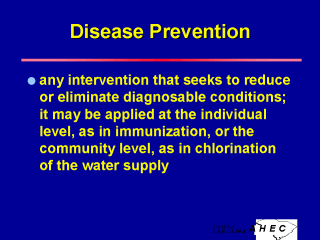Disease
prevention incorporates known strategies to help prevent disease. It includes measures
beyond lifestyle factors. Disease prevention is defined more specifically according to the
following levels:
- Primary prevention
- Secondary prevention
- Tertiary prevention
Interrelated Domains
Disease prevention overlaps the domains of behavioral science, education and public
health. Educational situations are often great opportunities to apply the ideas, theories,
methods, and techniques developed by psychologists. What united the interests and
contributions of the behavioral sciences and health education is the population-based
perspective provided by public health, especially regarding priority setting and
intervention approaches. All three are grounded in the liberal arts. The humanities link
the profession to the human condition. Biomedical sciences provide knowledge about the
underlying mechanisms in health and disease that guide the direction of public health
efforts.
